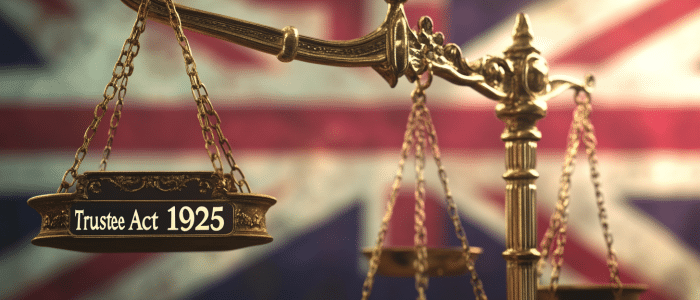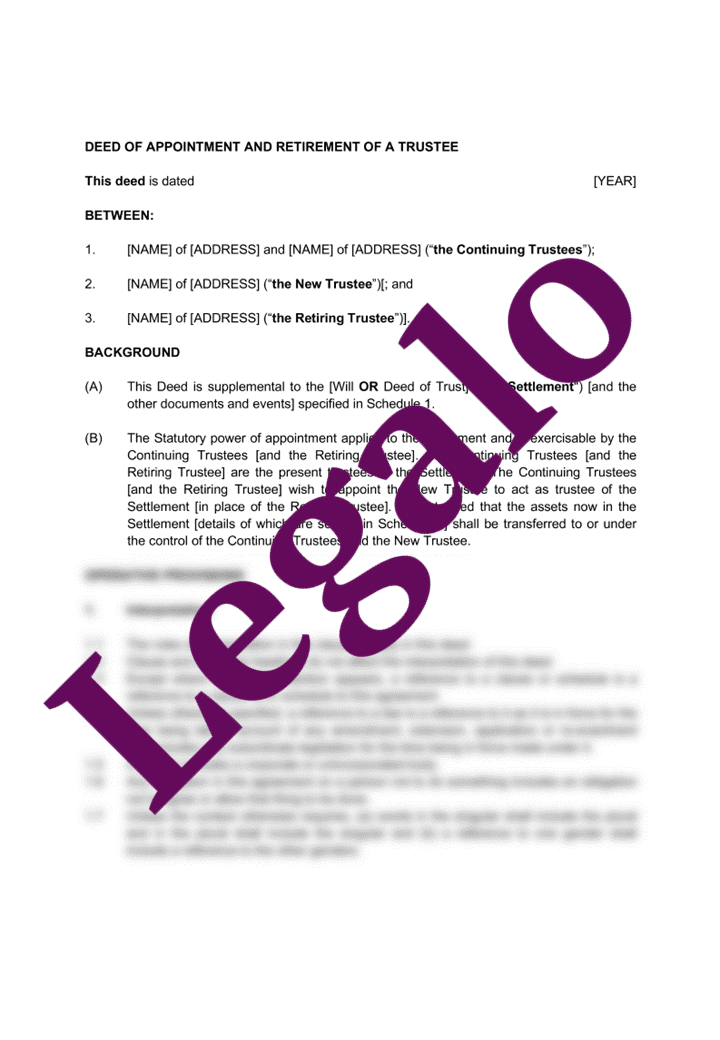Deed of Appointment of a Trustee
Our Deed of Appointment of a Trustee template:
- Appoints (and, if required, retire) trustees to an existing trust
- Takes less than 15 minutes to complete and produce your deed
- Comes with our money-back satisfaction guarantee
- Has been drafted by a UK solicitor for reliability
- Benefits from our free customer support line

How Does It Work?
-
1. Download
-
2. Edit
-
3. Print
-
4. Sign
MD, Legalo Ltd; Solicitor; Notary Public
What is a Deed of Appointment (and Retirement) of a Trustee?
A deed of appointment (and retirement) of a trustee is a legal document that you use either to:
- Appoint a new trustee to an existing trust; or
- Replace a retiring trustee in a trust with a new trustee.
We have drafted the template deed so that you can use it either:
- to appoint a new trustee; or
- both to retire a trustee and appoint a new trustee in their place.
The deed acts to both appoint the new trustee and to establish the rights and responsibilities of the incoming trustee.
If you only need to retire a trustee and not appoint a new one, then see our Deed of Retirement of a Trustee.
However, please note that the deed of appointment is not itself a trust deed and so it will not create a trust on its own. For that, you need to put a trust deed in place. Our guide to setting up a bare trust covers this in more detail.
People commonly use this deed of appointment (and retirement) of a new trustee in several contexts. For example, where it is necessary to replace a trustee that is retiring, or has passed away.
An alternative situation may be where the administration of the trust will benefit from appointing a new trustee with specific skills and experience.
Whatever your circumstances, Legalo has made appointing a new trustee, or retiring an existing trustee and appointing a replacement, simple with our Trustee Deed of Appointment template.
Drafted by David, a practising solicitor, and co-founder here at Legalo, our template deed provides a low cost and reliable solution for appointing (and, if needed, retiring) trustees.
If you were after a deed of appointment of assets in a trust, then click here.
When is a Deed of Appointment (and Retirement) Needed?
You should use a deed of appointment to make any change to the trusteeship of an existing trust.
You can use our Deed of Appointment for a New Trustee both (a) to appoint a new trustee, or (b) to appoint and retire an existing trustee, as you may require.
The precedent deed is simple to edit and includes full guidance notes to take you through the edits needed to complete the template.
If you find yourselves with any questions when completing the deed, you can call or email us. We will guide you through any questions that you may have that relate to completing the deed.
In the UK, section 36 of The Trustee Act 1925 governs the appointment and removal of trustees. This section of the Trustee Act allows for the appointment of a new trustee in situations where:
- A trustee is dead.
- A trustee remains outside of the UK for more than 12 months.
- The trustee decides to retire.
- A trustee refuses to act and you need to replace them.
- A trustee is unfit to act (e.g. due to misconduct or incapacity).
- The trustee is incapable of acting (e.eg, due to physical or mental incapacity).
Strictly speaking, the Trustee Act 1925 doesn’t require that you use a Deed of appointment when appointing or retiring a trustee. It simply requires under section 36(1) that the appointment or removal must be ‘in writing’.
It has, however, become common practice to use a deed to record the appointment and the retirement of a trustee.
The Trustee Act does not limit the new appointment of a trustee to the scenarios the Act covers. Let’s take a look at some of the more common scenarios where you can use our precedent deed template:
1. Retirement of a Trustee
A trustee does not have to hold their position for life. They have a choice as to whether to remain a trustee. As people age, or their circumstances change, it is not uncommon for a trustee to retire from their trustee position.
Depending on the terms of the Trust the retiring trustee may need to consent to their removal. Our deed template creates a deed of retirement and appointment of trustee because it makes provision for the retirement of an existing trustee as well as the appointment of a new trustee..
2. Death or Incapacity of a Trustee
If a trustee dies, or is in some way incapable, it may be necessary to record the removal of the trustee and appoint a new trustee in their place. The trust deed itself will set out the minimum number of trustees that the trust must have.
If the minimum number is still met after the death of a trustee it is not necessary to appoint a replacement trustee. However, it may be that the remaining trustees prefer to preserve the previous number of trustees and to appoint a new replacement trustee.
In this scenario, you will edit our template deed so that you crate a deed for the retirement of the trustee that you are removing and the appointment of the new trustee.
3. Appointment of Additional Trustees
It is common to use a deed of appointment to add an additional trustee in order to spread the administrative responsibilities across an extra person.
Depending on the nature of the trust, and the assets held within the trust it may be necessary to bring in additional, or new, expertise and experience.
You can use our Deed of Appointment in such a situation. You can easily edit the precedent template to remove reference to a retiring trustee, so that it only operates as a deed of appointment of a new trustee.
4. Misconduct or Breach of Duty
In rare cases, a trustee may have breached their fiduciary duties in some way, or have been involved in misconduct of some form.
In such circumstances the other trustees are likely to (a) require that the trustee in question resigns from their appointment, and (b) appoint a new trustee in their place.
So in this situation, it will be necessary to both (a) retire the existing trustee and (b) appoint their replacement trustee with the deed of appointment.
Appointing and Removing a Trustee – Legal Requirements
When appointing a new trustee, either with or without the removal of an existing trustee, it is, of course, critical that you do so in a way that ensures that the new appointment is valid.
In doing so, you must meet certain legal requirements and formalities.
Compliance with the Trust Deed
The trust deed is likely to contain provisions covering the appointment of a new trustee and the retirement of an existing trustee.
Since the trust deed governs the operation of the trust, you must adhere to its provisions , otherwise the appointment may not be valid.
If you are appointing a new trustee, make sure that (1) you have read the trust document and (2) you are carrying out the appointment of the trustee in accordance with the requirements of the trust deed.
Execution by All Relevant Parties
All relevant parties must sign the deed of appointment. This will be the existing trustees, the new trustee, and any retiring trustees.
You must have witnesses present when each party signs the deed for it to be valid. The witnesses must also be independent individuals who are not themselves parties to the trust.
So, you must carefully consider the execution of the deed of appointment (and retirement), but it is relatively straightforward. The Government provides detailed guidance on the execution of deeds, if you require further guidance.
Registration of The Change in Trustees
If the trust holds land or property, then you need to register the appointment, and / or removal of a trustee at the Land Registry. This is done by completing and filing From TR1 at the Land Registry. The Government guidance on filing Form TR1 can be read here.
Technically, this creates a transfer of the land into the names of the new trustees.
If this is relevant to your situation, then you may be concerned that a transfer of the land will give rise to a requirement to pay stamp duty. HMRC confirms that no stamp duty is payable where there is no consideration due on a change of trustees. See the HMRC Stamp Duty Land Tax Manual for further information on this.
Professional Drafting
Whilst not a legal requirement, you should make sure that your Deed of Appointment (and retirement, if relevant) has been professionally prepared. You can do this by either:
- Engaging a solicitor where you can expect to pay between £750 and £1250 plus VAT; or
- Purchasing and completing our professionally drafted Deed of Appointment and Retirement template. It costs just £50 and provides you peace of mind and great value for money.
Keep in mind too, that unlike many providers of legal document templates our templates have been drafted by practicing UK solicitors who own and operate Legalo.
We offer a free customer support helpline to guide you through any questions you may have on this deed.
Our helpline is available during usual business hours, to guide you through any question that you may have when completing the precedent template.
Appointing A Suitable Trustee
When Appointing a new trustee, either as an additional trustee, or to replace a retiring trustee it is important to consider the role of the trustee.
The main duty of a trustee is to manage the assets that are in the trust. They do this for the benefit of the trust’s beneficiaries. The duties that a trustee owes to the trust, and to the beneficiaries of the trust, are known as ‘fiduciary duties’.
The fiduciary duties of a trustee were historically derived from the common law. This means judge made law. However, the Trustee Act 2000 was introduced to provide statutory guidance on several key responsibilities. These include:
- Duty of Care. Section 1 of the Trustee Act 2000 sets out the statutory duty of care for trustees. It requires that they must exercise at least a reasonable level of skill and care in their function as a trustee.
- Powers of Investment. Sections 3 to 5 of The Trustees Act 2000 grants broad powers to make investments on behalf of the trust. It also requires that they take reasonable precautions such as diversification of investment and taking specialist advice where appropriate.
- Duty to review investments. Section 4 of the Trustees Act makes it a requirement that the trustees periodically review the investments that are being utilised. This is to make sure that they remain relevant and appropriate.
Depending on the nature of the assets held in the trust the role of the trustees may extend beyond basic trust administration. Care should therefore be given to the skill set and experience of a new trustee when appointing them.
Steps to Appoint (and Retire) a Trustee
I set out below the six key steps that you should follow when appointing a new trustee.
Step 1: Review the Trust Deed
The Trust Deed may set out a specific process for appointing a new trustee, and where relevant retiring an existing trustee. You should read the Trust Deed to establish what process is to be followed, if any. If the Trust Deed does not contain any specific requirements, then you can move onto step 2.
Step 2: Obtain Consent
Unless the Trust Deed, for example a deed of bare trust provides otherwise the existing trustees will need to agree to the new trustee’s appointment. They do this by executing the deed of appointment.
If a trustee will be retiring and replaced with the new incoming trustee, then you require their consent also. This deed of retirement and appointment of a new trustee template makes provision for this.
Step 3: Draft the Deed of Appointment (and Retirement)
As we explain above, you should put a deed of appointment of trustee in place. This has the effect of formalising the appointment and also of recording the consent of the relevant parties.
Step 4: Execute the Deed
Once drafted the deed of appointment (and retirement) will need to be signed in the presence of an independent witness. This exercise is called ‘executing’ the deed.
Deeds can be signed electronically but the person that acts as the witness must be physically present in the presence of each signatory to observe them signing. More than one witness can be used, if needed.
Step 5: Register the Deed (if Required)
In most instances the deed of appointment will not need to be registered. However, as we explain above, if the trust holds property, then the change in trustees will need to be registered with the Land Registry.
Step 6: Notify Interested Parties
Following the appointment of the new trustee all relevant parties should be notified. This will include the beneficiaries of the trust. If the trust holds money in a bank account, then you should inform the bank.
The Structure of a Deed of Appointment (and Retirement) of a Trustee
Deeds of appointment of a new trustee, and deeds that cover the retirement of an existing trustee and the appointment of a new replacement generally follow a traditional format.
Several essential elements must be included in the deed to make sure that it is legally valid. Other elements help to make sure that the document provides clarity and ensures that the appointment, and where relevant retirement, process is smooth.
Parties Involved
The deed of appointment (and Retirement) must set out the parties involved. This will be the current trustees, the new trustees and the retiring trustee. The deed must also make provision for each of these parties to sign the completed deed.
Background/Recitals
It is common, although not legally required, for the Deed of Appointment (and Retirement) to include a section that explains the background to the matter and it will make reference to the original trust. That trust may be a trust that either (a) a trust deed, or (b) the terms of a will, set up.
Interpretation of the Deed
Whilst not a legal requirement, deeds that are more comprehensive will include a section that sets out rules to support in the interpretation of words and clauses contained in the deed.
Our template deed of appointment and retirement includes a section covering interpretation. This section can be useful in the unlikely event that there is any future disagreement over the terms of the deed.
Operative provisions
This section of the deed sets out the terms of the actual appointment of the new trustee, and (where relevant) the retirement of a trustee you are removing.
In the next section of this guide to our Deed of Appointment and Retirement template I’ll take you through a summary of the clauses in our Deed of Appointment and Retirement of trustee template.
Clauses in Our Deed of Appointment and Retirement
Below, we have set out the main features of our template deed of appointment and retirement, so you can see what it comprises. You can also view a preview of the document by clicking the ‘preview’ button at the top of this page.
Included with the precedent template is a comprehensive guide that takes you through each step in editing and completing your deed.
In the parties clauses you will list the continuing trustees, the new trustee and, if there is a retiring trustee, that person also.
The background clauses set out what this deed is about and what trust or will has set it up.
Clause 1 of the Deed
This clause sets out some basic rules regarding the interpretation of the deed.
Clause 2 of the Deed
Clause 2 is the main clause in the deed of appointment of a trustee. It states that the continuing trustees are appointing the new trustee and the retiring trustee is retiring. There is a statutory power under the Trustee Act 1925 for trusts to appoint new trustees.
The will or trust deed, as applicable, may also specify a similar power for the trust. In clause 2.1, if there is no trustee who is retiring, then delete all the words in square brackets which refer to the retiring trustee and their retiring.
Clause 3 of the Deed
Clause 3 is about the law and jurisdiction. If any party is based abroad, you may wish to:
- change the jurisdiction clause to reflect this; and/or
- make it non-exclusive.
Where the trust is based in the UK, the jurisdiction should be exclusively that of England (covering England and Wales), Scotland or Northern Ireland as applicable (change it, if need be, if it is not England or Wales).
Schedules to the Deed of Appointment
In the schedules, you will list the background documents relevant to the trust and the principal assets of the trust.
Finally, the guide explains how you validly sign the deed of appointment of a trustee, using a witness.
FAQs on the Deed of Appointment (and Retirement)
Below, we have answered the most popular questions on the Internet on this topic.
Do I need a deed of appointment for a new trustee?
If you want to appoint a new or extra trustee or a replacement for a trustee who has died, retired or been removed, then you need to do so by a deed of appointment. If you simply have a situation of a trustee who has died (and you don’t want to appoint a replacement), then they cease to be a trustee automatically at that point. So there would be no need for a deed or retirement of the dead trustee.
Who signs a deed appointing a trustee?
The existing trustees sign a deed of appointment of a new trustee. Usually you need at least 2 trustees for this. If there are no trustees because the last one died, then the personal representatives of the last trustee should sign.
Does a deed of appointment also cover retirement of a trustee?
A deed of appointment can also cover the retirement of an existing trustee. In this instance, the document becomes a ‘deed of retirement and appointment of a new trustee’.
Our deed of appointment template can be easily edit to suit either scenario.
Can a trustee be removed without their consent?
Yes, you can remove a trustee without their consent in certain circumstances. These are due to their incapacity or in cases of misconduct. In the event of death, they automatically cease to be a trustee.
Can a sole trustee be appointed?
Yes, provided that:
- the deed of trust states that the trust may operate with just one trustee; and
- the trust does not own any land or buildings in the UK (otherwise you will need at least 2 trustees).
It is more common that a trust deed will require that the minimum number of trustees is at least two.
Can a beneficiary be appointed as a trustee?
Yes, a beneficiary can become a trustee. However, this is generally discouraged due to the possibility of a conflict of interest arising.
How much does a deed of appointment cost?
The cost of a deed of appointment of a new trustee depends on whether you:
- engage a solicitor; or
- prepare the deed yourself.
Based on our own experience and customer feedback, we estimate that a firm of solicitors would charge you between £750 and £1,200 plus VAT for a deed of appointment of trustees.
You can make significant savings by using a template deed of appointment from Legalo. Our template deed costs just £50. All of our templates come with significant savings on using a high street firm of solicitors.
What happens to a discretionary trust when the trustee dies?
The position on what happens to a discretionary trust when a trustee dies depends on whether there are surviving trustees, then they can appoint a new trustee by a deed of appointment of a trustee.
If there are no remaining trustees, normally the Personal Representatives of the last surviving Trustee can appoint new Trustees. You should also check the trust deed to see if it has other rules.
Can a deed of appointment be retrospective?
A deed of appointment of a trustee can only be retrospective in particular circumstances. You should seek legal advice. It is nearly always better not to try an make any legal document retrospective. You must never back-date anything having a possible impact on tax, as HMRC would see this as tax fraud.
What happens to land held in the name of a deceased trustee?
When a trust holds land in the name of a deceased trustee, the existing trustees should transfer the land to the new set of trustees. So you should contact the Land Registry (in the case of land situated in England and Wales) to check what you need to do to transfer the land out of the names of the old trustees to the new set of trustees.
This will probably include:
- your producing a death certificate to the Land Registry;
- forms ID1 for all parties not using a solicitor;
- a form TR1; and
- a form AP1.
You can download all those forms for free from the Land Registry website. There should be no Stamp Duty charge for such a transfer, as it is exempt.







